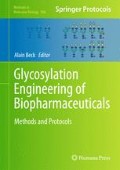Abstract
In order to improve therapeutic antibodies efficacy in cancer patients, several strategies were developed. One of these strategies consists in the enhancement of effector functions. Antibody-dependent cellular cytotoxicity (ADCC) was shown to mediate the activity of several therapeutic antibodies through interaction of the constant fragment (Fc) with immune cells. The interactions of Fc fragment can be modulated by engineering through modifications of the carbohydrate moieties or through modifications of some critical amino acids for its binding. Such modifications have to be studied in an in vitro assay to evaluate their impact on the regulation of effector functions. Here, we described a method to evaluate ADCC using a nonradioactive assay based on the measurement of lactate dehydrogenase (LDH) release. NK cells were purified by negative immunomagnetic selection and used as effector cells to trigger ADCC against specific target tumor cells. The LDH release measurement from lysed cells is performed after 4 h incubation. This method can replace the 51Cr release assay since it is less restrictive and highly sensitive.
Access this chapter
Tax calculation will be finalised at checkout
Purchases are for personal use only
References
Glennie MJ, French RR, Cragg MS, Taylor RP (2007) Mechanisms of killing by anti-CD20 monoclonal antibodies. Mol Immunol 44:3823–3837
Cragg MS, Walshe CA, Ivanov AO, Glennie MJ (2005) The biology of CD20 and its potential as a target for mAb therapy. Curr Dir Autoimmun 8:140–174
Oflazoglu E, Audoly LP (2010) Evolution of anti-CD20 monoclonal antibody therapeutics in oncology. MAbs 2:14–19
Galizia G, Lieto E, De Vita F, Orditura M, Castellano P, Troiani T et al (2007) Cetuximab, a chimeric human mouse anti-epidermal growth factor receptor monoclonal antibody, in the treatment of human colorectal cancer. Oncogene 26:3654–3660
Pescovitz MD (2006) Rituximab, an anti-cd20 monoclonal antibody: history and mechanism of action. Am J Transplant 6:859–866
Ravandi F, O’Brien S (2005) Alemtuzumab. Expert Rev Anticancer Ther 5:39–51
Watanabe M, Wallace PK, Keler T, Deo YM, Akewanlop C, Hayes DF (1999) Antibody dependent cellular phagocytosis (ADCP) and antibody dependent cellular cytotoxicity (ADCC) of breast cancer cells mediated by bispecific antibody, MDX-210. Breast Cancer Res Treat 53:199–207
Correia IR (2010) Stability of IgG isotypes in serum. MAbs 2:221–232
Yoo EM, Yu LJ, Wims LA, Goldberg D, Morrison SL (2010) Differences in N-glycan structures found on recombinant IgA1 and IgA2 produced in murine myeloma and CHO cell lines. MAbs 2:320–334
Liu XY, Pop LM, Vitetta ES (2008) Engineering therapeutic monoclonal antibodies. Immunol Rev 222:9–27
Ravetch JV, Bolland S (2001) IgG Fc receptors. Annu Rev Immunol 19:275–290
Bryceson YT, March ME, Ljunggren HG, Long EO (2006) Activation, coactivation, and costimulation of resting human natural killer cells. Immunol Rev 214:73–91
Nimmerjahn F, Ravetch JV (2008) Fcgamma receptors as regulators of immune responses. Nat Rev Immunol 8:34–47
Cartron G, Dacheux L, Salles G, Solal-Celigny P, Bardos P, Colombat P et al (2002) Therapeutic activity of humanized anti-CD20 monoclonal antibody and polymorphism in IgG Fc receptor FcgammaRIIIa gene. Blood 99:754–758
Bruhns P, Iannascoli B, England P, Mancardi DA, Fernandez N, Jorieux S et al (2009) Specificity and affinity of human Fcgamma receptors and their polymorphic variants for human IgG subclasses. Blood 113:3716–3725
Jefferis R (2009) Recombinant antibody therapeutics: the impact of glycosylation on mechanisms of action. Trends Pharmacol Sci 30:356–362
Bryceson YT, Chiang SC, Darmanin S, Fauriat C, Schlums H, Theorell J et al (2011) Molecular mechanisms of natural killer cell activation. J Innate Immun 3:216–226
Weng WK, Levy R (2003) Two immunoglobulin G fragment C receptor polymorphisms independently predict response to rituximab in patients with follicular lymphoma. J Clin Oncol 21:3940–3947
Beck A, Wurch T, Bailly C, Corvaia N (2010) Strategies and challenges for the next generation of therapeutic antibodies. Nat Rev Immunol 10:345–352
Lazar GA, Dang W, Karki S, Vafa O, Peng JS, Hyun L et al (2006) Engineered antibody Fc variants with enhanced effector function. Proc Natl Acad Sci U S A 103:4005–4010
Okazaki A, Shoji-Hosaka E, Nakamura K, Wakitani M, Uchida K, Kakita S et al (2004) Fucose depletion from human IgG1 oligosaccharide enhances binding enthalpy and association rate between IgG1 and FcgammaRIIIa.J Mol Biol 336:1239–1249
Shields RL, Lai J, Keck R, O’Connell LY, Hong K, Meng YG et al (2002) Lack of fucose on human IgG1 N-linked oligosaccharide improves binding to human Fcgamma RIII and antibody-dependent cellular toxicity. J Biol Chem 277:26733–26740
Beum PV, Lindorfer MA, Taylor RP (2008) Within peripheral blood mononuclear cells, antibody-dependent cellular cytotoxicity of rituximab-opsonized Daudi cells is promoted by NK cells and inhibited by monocytes due to shaving. J Immunol 181:2916–2924
Author information
Authors and Affiliations
Editor information
Editors and Affiliations
Rights and permissions
Copyright information
© 2013 Springer Science+Business Media New York
About this protocol
Cite this protocol
Broussas, M., Broyer, L., Goetsch, L. (2013). Evaluation of Antibody-Dependent Cell Cytotoxicity Using Lactate Dehydrogenase (LDH) Measurement. In: Beck, A. (eds) Glycosylation Engineering of Biopharmaceuticals. Methods in Molecular Biology, vol 988. Humana Press, Totowa, NJ. https://doi.org/10.1007/978-1-62703-327-5_19
Download citation
DOI: https://doi.org/10.1007/978-1-62703-327-5_19
Published:
Publisher Name: Humana Press, Totowa, NJ
Print ISBN: 978-1-62703-326-8
Online ISBN: 978-1-62703-327-5
eBook Packages: Springer Protocols

